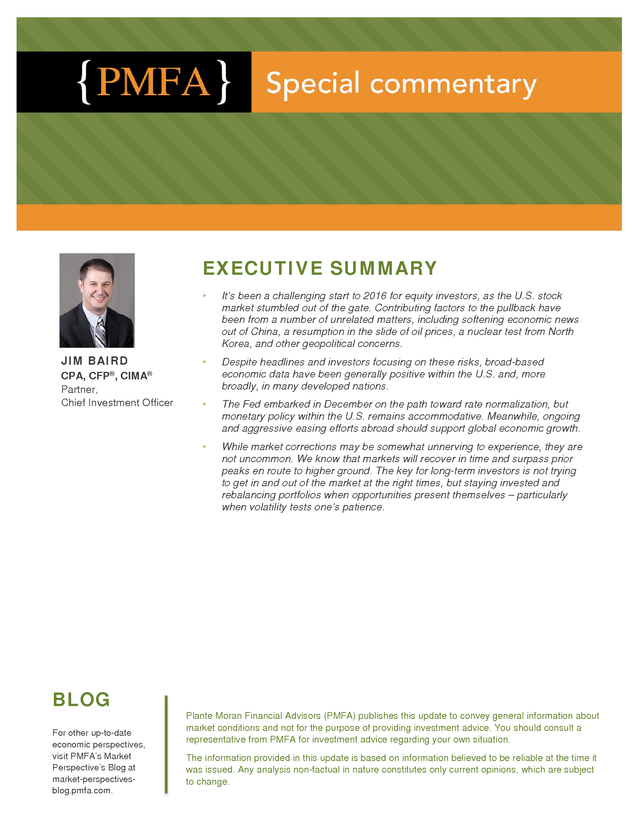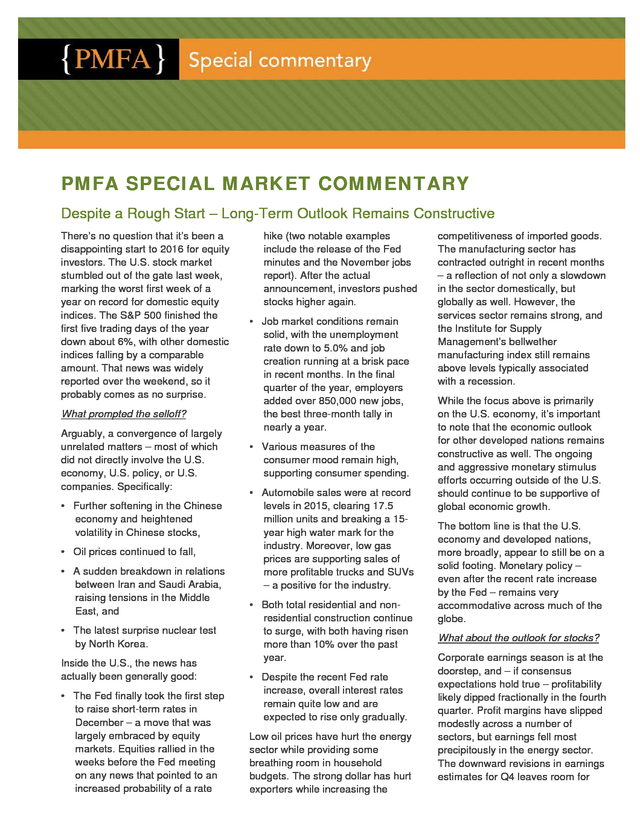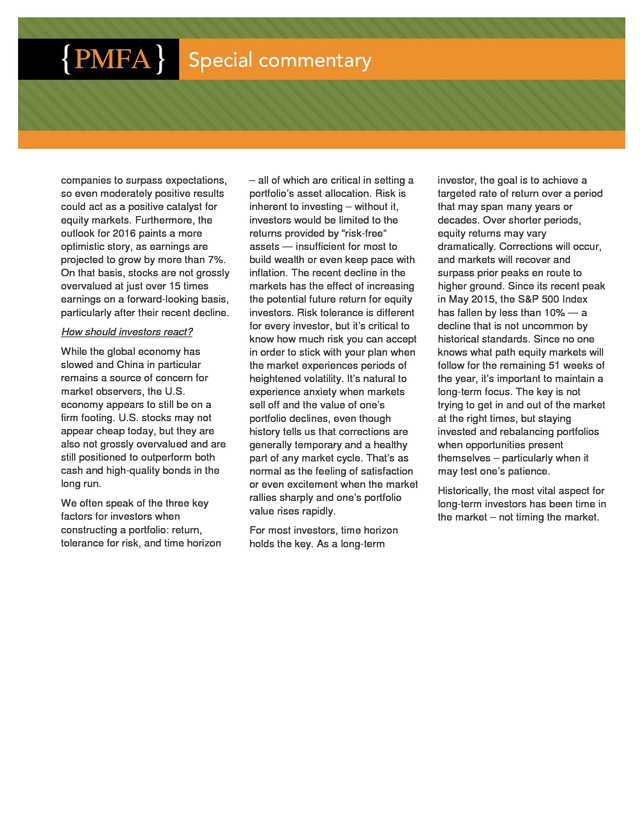Description
January 11, 2016
EXECUTIVE SUMMARY
•
It’s been a challenging start to 2016 for equity investors, as the U.S. stock
market stumbled out of the gate. Contributing factors to the pullback have
been from a number of unrelated matters, including softening economic news
out of China, a resumption in the slide of oil prices, a nuclear test from North
Korea, and other geopolitical concerns.
JIM BAIRD
•
CPA, CFP®, CIMA®
Partner,
Chief Investment Officer
Despite headlines and investors focusing on these risks, broad-based
economic data have been generally positive within the U.S. and, more
broadly, in many developed nations.
•
The Fed embarked in December on the path toward rate normalization, but
monetary policy within the U.S.
remains accommodative. Meanwhile, ongoing and aggressive easing efforts abroad should support global economic growth. • While market corrections may be somewhat unnerving to experience, they are not uncommon. We know that markets will recover in time and surpass prior peaks en route to higher ground.
The key for long-term investors is not trying to get in and out of the market at the right times, but staying invested and rebalancing portfolios when opportunities present themselves – particularly when volatility tests one’s patience. BLOG For other up-to-date economic perspectives, visit PMFA’s Market Perspective’s Blog at market-perspectivesblog.pmfa.com. Plante Moran Financial Advisors (PMFA) publishes this update to convey general information about market conditions and not for the purpose of providing investment advice. You should consult a representative from PMFA for investment advice regarding your own situation. The information provided in this update is based on information believed to be reliable at the time it was issued. Any analysis non-factual in nature constitutes only current opinions, which are subject to change. .
2 PMFA SPECIAL MARKET COMMENTARY Despite a Rough Start – Long-Term Outlook Remains Constructive There’s no question that it’s been a disappointing start to 2016 for equity investors. The U.S. stock market stumbled out of the gate last week, marking the worst first week of a year on record for domestic equity indices. The S&P 500 finished the first five trading days of the year down about 6%, with other domestic indices falling by a comparable amount.
That news was widely reported over the weekend, so it probably comes as no surprise. What prompted the selloff? Arguably, a convergence of largely unrelated matters – most of which did not directly involve the U.S. economy, U.S. policy, or U.S. companies. Specifically: • Further softening in the Chinese economy and heightened volatility in Chinese stocks, • Oil prices continued to fall, • A sudden breakdown in relations between Iran and Saudi Arabia, raising tensions in the Middle East, and • The latest surprise nuclear test by North Korea. Inside the U.S., the news has actually been generally good: • The Fed finally took the first step to raise short-term rates in December – a move that was largely embraced by equity markets.
Equities rallied in the weeks before the Fed meeting on any news that pointed to an increased probability of a rate hike (two notable examples include the release of the Fed minutes and the November jobs report). After the actual announcement, investors pushed stocks higher again. • Job market conditions remain solid, with the unemployment rate down to 5.0% and job creation running at a brisk pace in recent months. In the final quarter of the year, employers added over 850,000 new jobs, the best three-month tally in nearly a year. • Various measures of the consumer mood remain high, supporting consumer spending. • Automobile sales were at record levels in 2015, clearing 17.5 million units and breaking a 15year high water mark for the industry.
Moreover, low gas prices are supporting sales of more profitable trucks and SUVs – a positive for the industry. • Both total residential and nonresidential construction continue to surge, with both having risen more than 10% over the past year. • Despite the recent Fed rate increase, overall interest rates remain quite low and are expected to rise only gradually. Low oil prices have hurt the energy sector while providing some breathing room in household budgets. The strong dollar has hurt exporters while increasing the competitiveness of imported goods. The manufacturing sector has contracted outright in recent months – a reflection of not only a slowdown in the sector domestically, but globally as well. However, the services sector remains strong, and the Institute for Supply Management’s bellwether manufacturing index still remains above levels typically associated with a recession. While the focus above is primarily on the U.S.
economy, it’s important to note that the economic outlook for other developed nations remains constructive as well. The ongoing and aggressive monetary stimulus efforts occurring outside of the U.S. should continue to be supportive of global economic growth. The bottom line is that the U.S. economy and developed nations, more broadly, appear to still be on a solid footing. Monetary policy – even after the recent rate increase by the Fed – remains very accommodative across much of the globe. What about the outlook for stocks? Corporate earnings season is at the doorstep, and – if consensus expectations hold true – profitability likely dipped fractionally in the fourth quarter.
Profit margins have slipped modestly across a number of sectors, but earnings fell most precipitously in the energy sector. The downward revisions in earnings estimates for Q4 leaves room for . 3 companies to surpass expectations, so even moderately positive results could act as a positive catalyst for equity markets. Furthermore, the outlook for 2016 paints a more optimistic story, as earnings are projected to grow by more than 7%. On that basis, stocks are not grossly overvalued at just over 15 times earnings on a forward-looking basis, particularly after their recent decline. How should investors react? While the global economy has slowed and China in particular remains a source of concern for market observers, the U.S. economy appears to still be on a firm footing. U.S. stocks may not appear cheap today, but they are also not grossly overvalued and are still positioned to outperform both cash and high-quality bonds in the long run. We often speak of the three key factors for investors when constructing a portfolio: return, tolerance for risk, and time horizon – all of which are critical in setting a portfolio’s asset allocation.
Risk is inherent to investing – without it, investors would be limited to the returns provided by “risk-free” assets — insufficient for most to build wealth or even keep pace with inflation. The recent decline in the markets has the effect of increasing the potential future return for equity investors. Risk tolerance is different for every investor, but it’s critical to know how much risk you can accept in order to stick with your plan when the market experiences periods of heightened volatility.
It’s natural to experience anxiety when markets sell off and the value of one’s portfolio declines, even though history tells us that corrections are generally temporary and a healthy part of any market cycle. That’s as normal as the feeling of satisfaction or even excitement when the market rallies sharply and one’s portfolio value rises rapidly. For most investors, time horizon holds the key. As a long-term investor, the goal is to achieve a targeted rate of return over a period that may span many years or decades.
Over shorter periods, equity returns may vary dramatically. Corrections will occur, and markets will recover and surpass prior peaks en route to higher ground. Since its recent peak in May 2015, the S&P 500 Index has fallen by less than 10% — a decline that is not uncommon by historical standards.
Since no one knows what path equity markets will follow for the remaining 51 weeks of the year, it’s important to maintain a long-term focus. The key is not trying to get in and out of the market at the right times, but staying invested and rebalancing portfolios when opportunities present themselves – particularly when it may test one’s patience. Historically, the most vital aspect for long-term investors has been time in the market – not timing the market. .
remains accommodative. Meanwhile, ongoing and aggressive easing efforts abroad should support global economic growth. • While market corrections may be somewhat unnerving to experience, they are not uncommon. We know that markets will recover in time and surpass prior peaks en route to higher ground.
The key for long-term investors is not trying to get in and out of the market at the right times, but staying invested and rebalancing portfolios when opportunities present themselves – particularly when volatility tests one’s patience. BLOG For other up-to-date economic perspectives, visit PMFA’s Market Perspective’s Blog at market-perspectivesblog.pmfa.com. Plante Moran Financial Advisors (PMFA) publishes this update to convey general information about market conditions and not for the purpose of providing investment advice. You should consult a representative from PMFA for investment advice regarding your own situation. The information provided in this update is based on information believed to be reliable at the time it was issued. Any analysis non-factual in nature constitutes only current opinions, which are subject to change. .
2 PMFA SPECIAL MARKET COMMENTARY Despite a Rough Start – Long-Term Outlook Remains Constructive There’s no question that it’s been a disappointing start to 2016 for equity investors. The U.S. stock market stumbled out of the gate last week, marking the worst first week of a year on record for domestic equity indices. The S&P 500 finished the first five trading days of the year down about 6%, with other domestic indices falling by a comparable amount.
That news was widely reported over the weekend, so it probably comes as no surprise. What prompted the selloff? Arguably, a convergence of largely unrelated matters – most of which did not directly involve the U.S. economy, U.S. policy, or U.S. companies. Specifically: • Further softening in the Chinese economy and heightened volatility in Chinese stocks, • Oil prices continued to fall, • A sudden breakdown in relations between Iran and Saudi Arabia, raising tensions in the Middle East, and • The latest surprise nuclear test by North Korea. Inside the U.S., the news has actually been generally good: • The Fed finally took the first step to raise short-term rates in December – a move that was largely embraced by equity markets.
Equities rallied in the weeks before the Fed meeting on any news that pointed to an increased probability of a rate hike (two notable examples include the release of the Fed minutes and the November jobs report). After the actual announcement, investors pushed stocks higher again. • Job market conditions remain solid, with the unemployment rate down to 5.0% and job creation running at a brisk pace in recent months. In the final quarter of the year, employers added over 850,000 new jobs, the best three-month tally in nearly a year. • Various measures of the consumer mood remain high, supporting consumer spending. • Automobile sales were at record levels in 2015, clearing 17.5 million units and breaking a 15year high water mark for the industry.
Moreover, low gas prices are supporting sales of more profitable trucks and SUVs – a positive for the industry. • Both total residential and nonresidential construction continue to surge, with both having risen more than 10% over the past year. • Despite the recent Fed rate increase, overall interest rates remain quite low and are expected to rise only gradually. Low oil prices have hurt the energy sector while providing some breathing room in household budgets. The strong dollar has hurt exporters while increasing the competitiveness of imported goods. The manufacturing sector has contracted outright in recent months – a reflection of not only a slowdown in the sector domestically, but globally as well. However, the services sector remains strong, and the Institute for Supply Management’s bellwether manufacturing index still remains above levels typically associated with a recession. While the focus above is primarily on the U.S.
economy, it’s important to note that the economic outlook for other developed nations remains constructive as well. The ongoing and aggressive monetary stimulus efforts occurring outside of the U.S. should continue to be supportive of global economic growth. The bottom line is that the U.S. economy and developed nations, more broadly, appear to still be on a solid footing. Monetary policy – even after the recent rate increase by the Fed – remains very accommodative across much of the globe. What about the outlook for stocks? Corporate earnings season is at the doorstep, and – if consensus expectations hold true – profitability likely dipped fractionally in the fourth quarter.
Profit margins have slipped modestly across a number of sectors, but earnings fell most precipitously in the energy sector. The downward revisions in earnings estimates for Q4 leaves room for . 3 companies to surpass expectations, so even moderately positive results could act as a positive catalyst for equity markets. Furthermore, the outlook for 2016 paints a more optimistic story, as earnings are projected to grow by more than 7%. On that basis, stocks are not grossly overvalued at just over 15 times earnings on a forward-looking basis, particularly after their recent decline. How should investors react? While the global economy has slowed and China in particular remains a source of concern for market observers, the U.S. economy appears to still be on a firm footing. U.S. stocks may not appear cheap today, but they are also not grossly overvalued and are still positioned to outperform both cash and high-quality bonds in the long run. We often speak of the three key factors for investors when constructing a portfolio: return, tolerance for risk, and time horizon – all of which are critical in setting a portfolio’s asset allocation.
Risk is inherent to investing – without it, investors would be limited to the returns provided by “risk-free” assets — insufficient for most to build wealth or even keep pace with inflation. The recent decline in the markets has the effect of increasing the potential future return for equity investors. Risk tolerance is different for every investor, but it’s critical to know how much risk you can accept in order to stick with your plan when the market experiences periods of heightened volatility.
It’s natural to experience anxiety when markets sell off and the value of one’s portfolio declines, even though history tells us that corrections are generally temporary and a healthy part of any market cycle. That’s as normal as the feeling of satisfaction or even excitement when the market rallies sharply and one’s portfolio value rises rapidly. For most investors, time horizon holds the key. As a long-term investor, the goal is to achieve a targeted rate of return over a period that may span many years or decades.
Over shorter periods, equity returns may vary dramatically. Corrections will occur, and markets will recover and surpass prior peaks en route to higher ground. Since its recent peak in May 2015, the S&P 500 Index has fallen by less than 10% — a decline that is not uncommon by historical standards.
Since no one knows what path equity markets will follow for the remaining 51 weeks of the year, it’s important to maintain a long-term focus. The key is not trying to get in and out of the market at the right times, but staying invested and rebalancing portfolios when opportunities present themselves – particularly when it may test one’s patience. Historically, the most vital aspect for long-term investors has been time in the market – not timing the market. .
Plante Moran Financial Advisors















